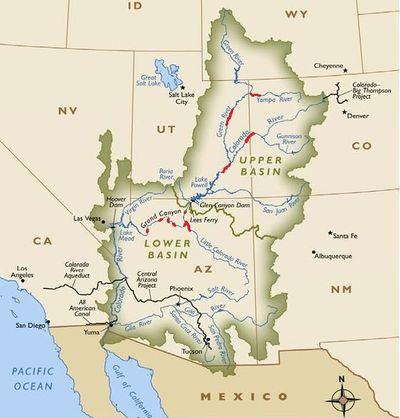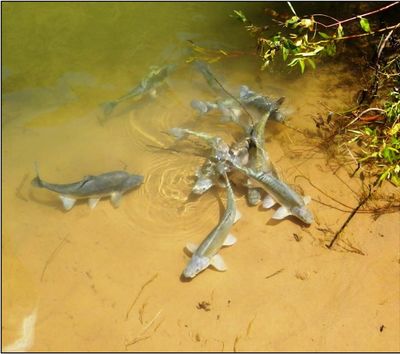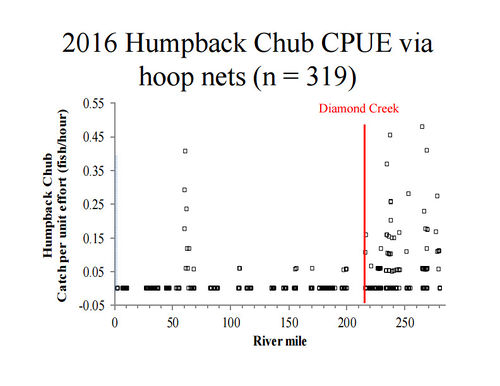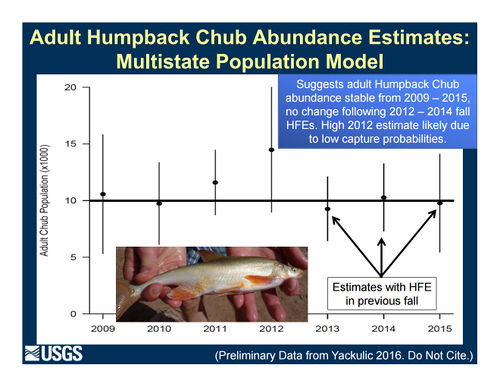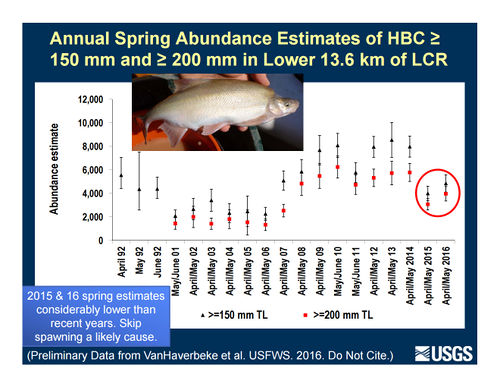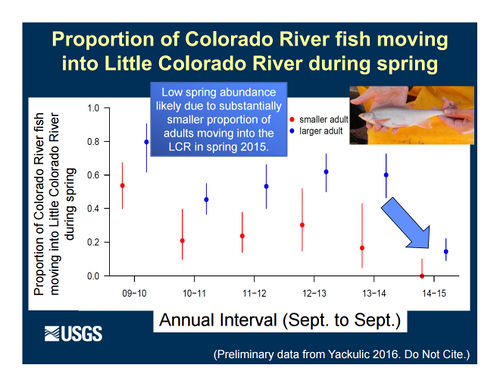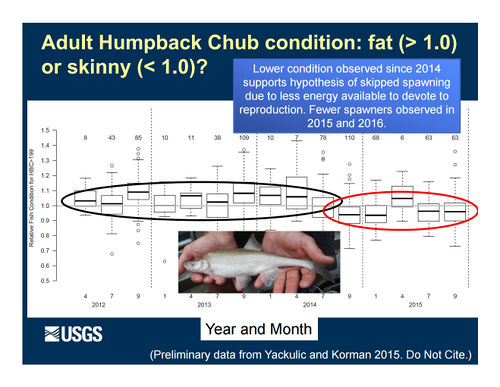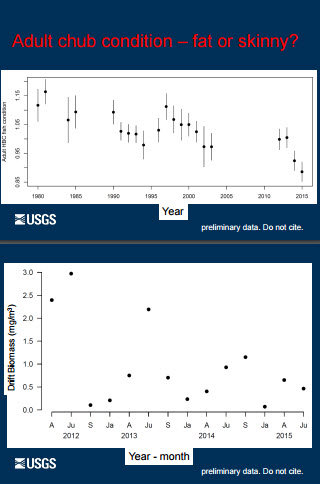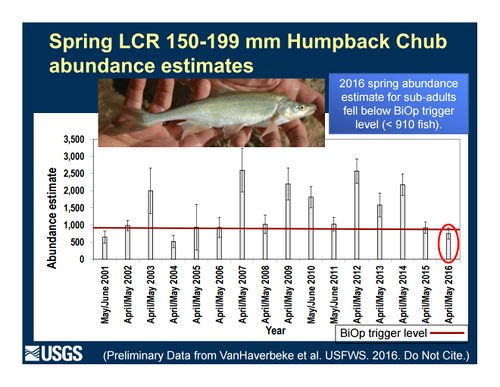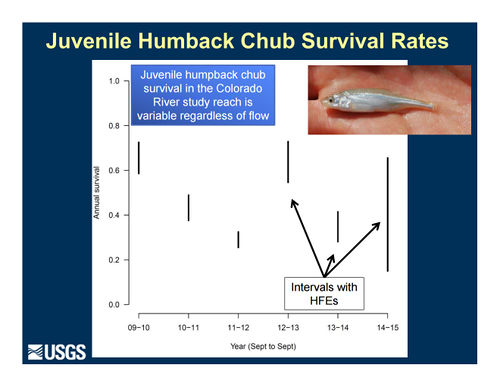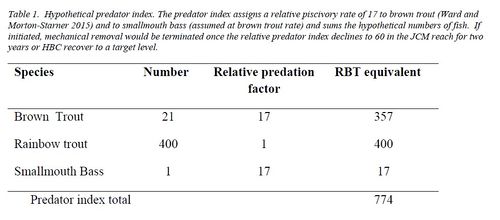|
Ongoing actions:
Reclamation would continue to support the NPS, FWS, GCMRC, and GCDAMP in
funding and implementing translocations of humpback chub into tributaries of the
Colorado River in Marble and Grand Canyons, and in monitoring the results of these
translocations, consistent with agencies’ plans and guidance (e.g., NPS Comprehensive
Fisheries Management Plan [CFMP], FWS Humpback Chub Genetics Management Plan
and Translocation Framework, and GCMRC Triennial Work Plan). Translocations allow
for opportunities to expand the area occupied by humpback chub and improve the overall
status of the species. Specifically, the following would occur:
- Humpback chub would be translocated from the lower reaches of the Little Colorado River to areas above Chute Falls in an effort to increase growth rates and survivorship.
- Monitoring would be conducted annually, or as needed, depending on the data required, to determine survivability, population status, or genetic integrity of the Havasu Creek humpback chub population. Intermittent translocations of additional humpback chub in Havasu Creek would be conducted if the FWS and NPS determine it is necessary to maintain genetic integrity of the population.
Reclamation would continue to fund a spring and fall population estimate annually, or at
a different frequency as deemed appropriate in consultation with FWS, using a mark
recapture based model for the Little Colorado River or the most appropriate model
developed for the current collecting techniques and data. Monitoring the chub population
allows us to determine its status (whether it is stable, increasing, or decreasing).
Reclamation would continue to fund control or removal of nonnative fish in tributaries
prior to chub translocations depending on the existing fish community in each tributary.
Reclamation, NPS, and FWS would lead any investigation into the possibility of using a
chemical piscicide, or other tools, as appropriate. Tributaries and the appropriate control
methods would be identified by the FWS, NPS, Reclamation, and GCMRC, in
consultation with the Arizona Game and Fish Department (AGFD). Depending on the
removal methods identified, additional planning and compliance may be necessary.
Removal of nonnative fishes improves the status of chub and other native fishes by
reducing competition and predation. The regulation and control of nonnative fish is a
management action identified in the Humpback Chub Recovery Goals (USFWS 2002a)
and Razorback Sucker Recovery Goals (USFWS 2002b).
Reclamation would continue to fund the FWS in maintenance of a humpback chub refuge
population at a federal hatchery (Reclamation has assisted the FWS in creating a
humpback chub refuge at the Southwestern Native Aquatic Resources and Recovery
Center [SNARRC]) or other appropriate facility by providing funding to assist in annual
maintenance (including the collection of additional humpback chub from the Little
Colorado River for this purpose). In the unlikely event of a catastrophic loss of the
Grand Canyon population of humpback chub, the refuge would provide a permanent
source of sufficient numbers of genetically representative stock for repatriating the
species.
Reclamation would continue to assist the FWS, NPS and the GCDAMP to ensure that a
stable or upward trend of humpback chub mainstem aggregations can be achieved by:
- Continuing to conduct annual monitoring of the Little Colorado River humpback chub aggregation (e.g., juvenile chub monitoring parameters). Periodically, an open or multistate model should be run to estimate abundance of the entire Little Colorado River aggregation inclusive of mainstem fish.
- Supporting annual monitoring in the mainstem Colorado River to determine status and trends of humpback chub and continuing to investigate sampling and analytical methods to estimate abundance of chub in the mainstem.
- Conducting periodic surveys to identify additional aggregations and individual humpback chub.
- Evaluating existing aggregations and determining drivers of these aggregations, for example, recruitment, natal origins, spawning locations, and spawning habitat (e.g., consider new and innovative methods such as telemetry or the Judas-fish approach) (Kegerries et al. 2015).
- Exploring means of expanding humpback chub populations outside of the Little Colorado River Inflow aggregation. Evaluate the feasibility of mainstem augmentation of humpback chub that would include larval collection, rearing, and release into the mainstem at suitable areas outside of or within existing aggregations.
Reclamation would, through the GCDAMP, conduct disease and parasite monitoring in
humpback chub and other fishes in the mainstem Colorado. The GCMRC is currently
conducting parasite monitoring in the Little Colorado River. However, in order to better
understand how/if disease and parasites (primarily Asian tapeworm) are affecting chub
and how temperature differences may affect parasite occurrence, this work would be
expanded to include investigations of parasites in humpback chub (and surrogate fish if
necessary) in the mainstem. Ensuring adequate protection from diseases and parasites is
an identified management action needed in the Humpback Chub Recovery Goals
(USFWS 2002a) and Razorback Sucker Recovery Goals (USFWS 2002b).
New actions:
Reclamation would collaborate with the FWS, GCMRC, NPS, and the Havasupai Tribe
to conduct preliminary surveys and a feasibility study for translocation of humpback chub into Upper Havasu Creek (above Beaver Falls). The implementation of surveys and
translocations, following the feasibility study, would be dependent on interagency
discussions, planning and compliance, and resulting outcomes of tribal consultation. As
stated above, translocations of chub into currently unoccupied habitat aid in expanding
the area occupied by the species. In addition, using a tributary to the Colorado River,
such as Upper Havasu Creek, protects translocated fish from the effects of dam
operations in the mainstem, but still allow for chub in Havasu Creek to contribute to the
mainstem population.
Reclamation would, in cooperation with the FWS, NPS, GCMRC, and AGFD, explore
and evaluate other tributaries for potential translocations.
|
Tier 1 Trigger – Early Intervention Through Conservation Actions:
- 1a. If the combined point estimate for adult HBC (adults defined ≥200 mm) in the Colorado River mainstem LCR aggregation; RM 57-65.9) and Little Colorado River (LCR) falls below 9,000 as estimated by the currently accepted HBC population model (e.g., ASMR, multi-state).
-OR-
- 1b. If recruitment of sub-adult HBC (150-199mm) does not equal or exceed estimated adult mortality such that:
- Sub-adult abundance falls below a three-year running average of 1,250 fish in the spring LCR population estimates, or
- Sub-adult abundance falls below a three-year running average of 810 fish in the mainstem Juvenile Chub Monitoring reach (JCM annual fall population estimate; RM 63.45-65.2).
Tier 1 Trigger Response:
- Tier 1 conservation actions listed below will be immediately implemented either in the LCR or in the adjacent mainstem. Conservation actions will focus on increasing growth, survival and distribution of HBC in the LCR & LCR mainstem aggregation area.
Tier 2 Trigger - Reduce threat using mechanical removal if conservation actions in Tier 1 are insufficient to arrest a population decline:
Mechanical removal of nonnative aquatic predator will ensue:
- If the point abundance estimate of adult HBC decline to <7,000, as estimated by the currently accepted HBC population model.
Mechanical removal will terminate if:
- Predator index (described below) is depleted to less than 60 RBT/km for at least two years in the JCM reach (RM 60.0-64.5) and immigration rate is low (the long term feasibility of using immigration rates as a metric still needs to be assessed),
-OR-
- Adult HBC population estimates exceed 7,500 and recruitment of sub-adult chub exceed adult mortality for at least two years.
If immigration rate of predators into JCM reach is high, mechanical removal may need to continue. These triggers are intended to be adaptive based on ongoing and future research (e.g., Lees Ferry recruitment and emigration dynamics, effects of trout suppression flows, effects of Paria River turbidity inputs on predator survival and immigration rates, interactions between humpback chub and rainbow trout, other predation studies).
|

